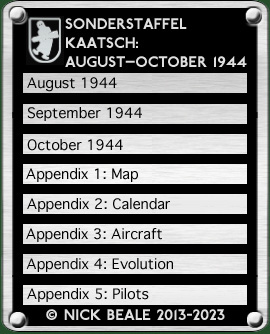|
Not only German troops from Southern France, but those from as far west as the Atlantic seaboard were withdrawing toward the area between the Jura and Vosges mountain ranges, the so-called Belfort Gap, through which they hoped to reach the German border, while the forces already there held the way open. In consequence, Luftflotte 3’s most urgent assignment for FAG 123 was coverage of the area south east of the line Besançon – Pontarlier. Two Bf 109 duly carried out a reconnaissance, obtaining photos of a strip of territory between Nancy and Belfort. Of 18 bridges over the Rivers Moselle and Meurthe and the canal linking the two, eight were destroyed, one damaged and nine intact. In Épinal the northerly bridges were down but those in the southern part of the town were undamaged; the barracks and hangars of Luxeuil aerodrome had been destroyed. In a message that morning Ob. West, von Rundstedt, responded to a signal issued by OKL on 7 September: “I consider the order to cut back on the Luftwaffe’s combat operations on account of the fuel situation unacceptable for the West … on the grounds of the intensified reconnaissance urgently necessitated by the military situation …” During the day, 5.(F)/123 filed a return on its pilot status: Obltn. Kaiser, sick; Ltn. Weber, detached [to Dijon]; Ofhr. Stütz, conditionally ready; (name not intercepted), conditionally ready; Uffz. Mittermayer, ready; Uffz. Geisser, in hospital; Uffz. Kuhlmann, detached [to Dijon]; Uffz. Lück, ready; Uffz. Müller, detached [to Dijon]; Uffz. Büttner, Uffz. Krestan and Gefr. Mack, conditionally ready. Casualties had been: Obltn. Spiess, crashed on 28 August and Gefr. Schmidt, crashed on 31 August.
FAG 123’s Kommandeur gave out that the Staffel was to prepare for immediate transfer to Gelsenkirchen-Buer (30 km. WNW of Dortmund and 200 km. NNW of Mommenheim) with signals and principal technical personnel going by road while the rest unit should go by rail. The final transfer order was to follow. The next afternoon Oblt. Kaiser responded that rail transport was “probably assured” by the 16th but later advised his Kommandeur that the Staffel’s other elements could not transfer as no fuel for road vehicles could be “scraped up from anywhere.” It was only at 14.30 hrs. on the 12th that Kaiser was able to report that fuel for motor transport had been allocated and the transfer would be taking place at once. The Staffel had a strength of 11 x Bf 109 G-6 and one Fi 156 on 10 September.
The 5.(F)/123 was ordered to carry out a reconnaissance of the area Vesoul – Belfort – Besançon (places in Kaatsch’s sphere of operations). Leutnant Heinz Moschke logged a 75-minute operational flight in Bf 109 "3", taking off from Freiburg and landing in Mulhouse.
On this date the Kaatsch Staffel was reported as being disbanded. It was also being directed to cover Belfort, Vesoul, Pontarlier and Delle (a town on the Franco-Swiss border) to establish the progress of German withdrawals and Allied crossings of the Doubs. It was also being directed to cover Belfort, Vesoul, Pontarlier and Delle (a town on the Franco-Swiss border) to establish the progress of German withdrawals and Allied crossings of the Doubs. At 09.50 hrs., 3 km. south west of Charmes, Ltn. Bell shot down and Auster; his two previous claim had been credited to Stab/JGr. 200 but now his unit was recorded as Aufklärungsstaffel Kaatsch:
Two aircraft flew battle reconnaissance for Nineteenth Army in the area Toul – Nancy – Luneville – Mirecourt – Neufchâteau, supposedly for Nineteenth Army but well north of its area of operations. According to FAG 123’s report this was — in the stock Luftwaffe phrase — “without particular incidents” («ohne besonderen Ereignisse», a standard reporting phrase).
Kaatsch was ordered to undertake battle reconnaissance, under direct instruction from Nineteenth Army but it is not clear if sorties were actually flown. For the following day by contrast the Army was to pass its requirements via FAG 123.
The US 36th Inf. Div. (attached to the French First Army) was now fighting to outflank Luxeuil-Les-Bains and its aerodrome and would enter the city next morning. Leutnant Heinz Moschke, with Uffz. Reinhold Winter as his wingman, flew a mission from Freiburg to Eastern France, taking off at 18.25 hours. When 10 km. North of Mirecourt, they came on an American artillery spotter. Moschke made two passes, scoring hits on the starboard wing and cockpit before the “Auster” fell away to port, into a wood. They returned to Freiburg after 65 minutes in the air and Moschke was credited by Maj. Kaatsch with his second victory (the first had been scored with JGr. 200 on 14 July). For this latest kill, Moschke had flown a Bf 109 G-6/U4 marked “11” but had not used its MK 108 cannon, just the MG 131 machine guns. Luftflotte 3 decided that Jagdgruppe 200 should be disbanded “with the exception of the crews at present with Sonderstaffel Kaatsch.” Four days after that, JGr. 200 in Bierstadt (an eastern suburb of Wiesbaden, Germany) itself relayed news of its disbandment to “Aufklärungsstaffel K” which was also now on home soil, at Freiburg-im-Breisgau. continued on next page …
|
||||||||
TIMELINE |
|
10 September |
US troops enter Luxembourg. |
11 September |
1st French Division takes Dijon; US Third and Seventh Armies link up west of the city; Americans cross German border near Trier. |
12 September |
American troops reach Vesoul. |
14 September |
Luxeuil-les-Bains liberated. |
17 September |
Holland: Operation Market-Garden begins. |


